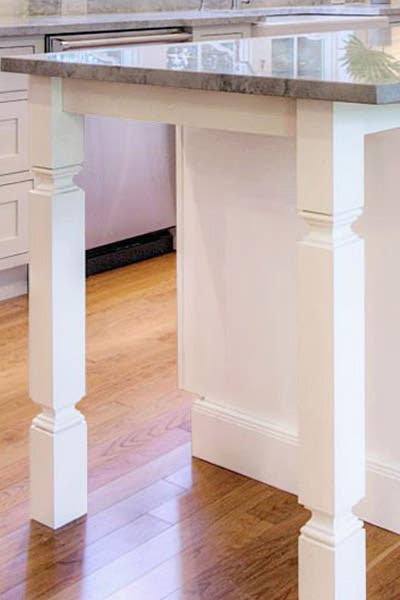A Guide to Choosing the Perfect Legs For Cooking Area Island for Your Home
Picking the optimal legs for your kitchen area island is a nuanced choice that impacts both the performance and visual charm of this main space. As you take into consideration these aspects, it ends up being obvious that the best legs can transform not just the look of your kitchen area however additionally its usability for years to come.

Comprehending Cooking Area Island Legs
When choosing legs for a kitchen island, it's important to comprehend their aesthetic and functional roles in the overall design. The legs function as a crucial support group, ensuring security and longevity for the island, which commonly operates as a work space, dining area, or gathering spot. Therefore, the selection of material and building strategy have to be durable adequate to hold up against daily use and prospective wear.
In enhancement to their architectural responsibilities, legs contribute substantially to the island's aesthetic appeal. They can boost the kitchen area's design, whether via standard, contemporary, or eclectic designs. The height and proportion of the legs are also crucial factors to consider; they have to balance with the island's countertop height while ensuring comfortable seating for those using the space.
Furthermore, the leg layout can affect the total flow of the cooking area. Open, airy leg styles can produce a feeling of lightness, while solid, substantial legs might communicate a more based and steady visual - Legs For Kitchen Island. Comprehending these visual and useful elements will certainly direct homeowners in making notified options that enhance their cooking area's layout and boost its functionality
Popular Styles and Materials
The choice of legs for a cooking area island incorporates a selection of popular styles and products, each offering distinct qualities that can boost both functionality and aesthetics. Conventional legs usually show elaborate information and craftsmanship, enhancing traditional kitchen layouts.

Elevation and Security Considerations

Stability is one more vital factor to consider. The legs of the kitchen island must provide ample support, making sure that the structure can endure daily usage without shifting or tottering. Material selection plays a considerable function in security; steel legs, as an example, often tend to supply greater toughness compared to wood. Furthermore, making sure that the island is securely secured to the flooring or wall surface can boost stability, especially for bigger islands that might bear substantial weight.
Matching Your Cooking Area Visual
Choosing the right legs for your cooking area island goes past capability; it also plays a substantial function in the general aesthetic of the area (Legs find out here For Kitchen Island). When choosing legs, consider the layout style of your kitchen area.
Color is an additional important aspect. Legs that enhance or comparison with your island's surface area and bordering cabinetry can produce aesthetic consistency or striking prime focus. As an example, matching dark wood legs with a light marble kitchen counter can include deepness and passion. Furthermore, think about the finish of the legs; matte, glossy, or textured finishes can substantially impact the overall feeling of the kitchen.
Installment and Upkeep Tips
Installing kitchen area island legs requires careful focus to detail to guarantee both stability and visual charm. Begin by selecting an appropriate location for your island, ensuring it is degree and has enough room for motion. Utilize a stud finder to situate wall surface studs if you are attaching the legs to a wall surface or making use of brackets for included assistance. Mark the positioning of the legs precisely read review prior to exploration.
When safeguarding the legs, utilize top notch screws and, if required, timber adhesive for added strength. For steel legs, guarantee that you are utilizing suitable anchors and devices to stop damage to your floor covering. It is a good idea to examine for levelness after installation, making modifications as needed to prevent wobbling.
Tidy the legs with an appropriate cleaner, preventing unpleasant materials that might damage the surface. Click This Link By following these installment and upkeep tips, you can make sure that your cooking area island legs stay both practical and aesthetically enticing.
Final Thought
In conclusion, picking the ideal legs for a kitchen area island demands careful factor to consider of elevation, security, and aesthetic compatibility. Ultimately, thoughtful leg choice plays a critical function in elevating both the practicality and design of the cooking area space.
When choosing legs for a kitchen island, it's important to recognize their practical and aesthetic functions in the total design. Open, ventilated leg styles can create a sense of lightness, while solid, considerable legs might share a much more grounded and secure visual. The legs of the kitchen area island must offer sufficient assistance, ensuring that the structure can stand up to day-to-day use without changing or tottering.Setting up kitchen island legs calls for mindful interest to detail to make sure both stability and aesthetic appeal.In verdict, choosing the suitable legs for a kitchen island requires mindful factor to consider of elevation, security, and aesthetic compatibility.